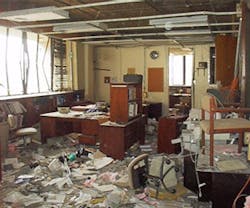Where Would Your Facility Be Vulnerable to Brussels-Style Blasts?
The terrorist bombings in Brussels again focus intense scrutiny on facility security and life safety. How would your facility respond to an explosive attack?
Because a true blast-resistant approach is not feasible for most buildings, the focus should more likely be on an incremental approach to mitigate damage. An important consideration here is managing the amount of explosive material that an attacker may bring in proximity to a building. Think of your security lines as a sieve – each one should reduce the potential size of an explosive charge as an attacker gets closer.
A bomb in a vehicle has the potential to cause the greatest damage because the charge could weigh hundreds or even thousands of pounds, resulting in an explosion large enough to cause structural collapse. According to a guide from the Federal Emergency Management Agency (FEMA), Primer for Design of Commercial Buildings to Mitigate Terrorist Attacks, critical locations for bomb-laden vehicles include underground parking areas, loading docks, and curbside locations closest to the building.
Suitcase-sized bombs, such as those reported to have been used in the in the Brussels airport attack, can contain explosive charges of 50 to 100 pounds. While smaller than vehicle charges, these charges would likely be easier to maneuver near a building target.
Suicide explosives strapped to an attacker typically weigh only 5 to 10 pounds. However, they are easiest to get close to, or deep inside, the target.
Think about Debris
Much of the damage from an explosion is caused by flying debris. This occurs not only during the blast, as debris is blown away from the bomb, but also debris returning to the bomb location as air rushes back into the temporary vacuum created by the blast.
Debris from walls, ceilings and windows are prime sources of occupant injuries. To reduce them, building managers should think about the likely locations of blasts, predict damage nodes, and then determine how best to shield occupants from the projected debris.
